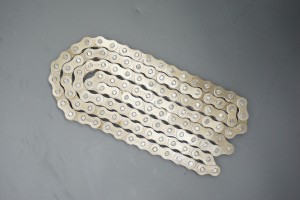Roller chains are a fundamental component of many mechanical systems and play a vital role in efficiently and reliably transmitting power. From bicycles to industrial machinery, knowing how to use roller chain is critical to ensuring smooth operation and preventing unnecessary downtime. In this blog, we delve into the world of roller chains, exploring their anatomy, maintenance and proper handling techniques.
Anatomy of a roller chain:
Roller chains consist of a series of interconnected links consisting of inner plates, outer plates, pins, bushings and rollers. Each component has a designated function for efficient power transfer. The inner and outer plates provide rigidity to the chain, while pins connect the plates, holding them together. The bushing acts as a buffer between the pin and the inner plate, preventing wear and allowing smooth rotation. Finally, the rollers engage the sprockets, helping the chain articulate smoothly.
Choose the right roller chain for your application:
Selecting the correct roller chain for a specific application is critical to achieving optimum performance and service life. Consider factors such as the required power transmission capacity, speed, environmental conditions and the loads the chain will be carrying. Additionally, roller chains must be matched with compatible sprockets to ensure proper fit and alignment. It is highly recommended to consult the manufacturer’s specifications or seek expert advice to make an informed decision.
Correct roller chain installation:
Proper installation is essential to maximize the functionality of your roller chain. Start by making sure the sprocket is properly aligned and securely attached to the shaft. Next, carefully wind the chain around the sprockets, making sure it engages the teeth of both sprockets. Sufficient tension should be applied to keep the chain from slack but not too tight. Regular inspection of the chain for any signs of misalignment, wear or damage is essential to avoid potential chain failure.
Maintenance and lubrication:
Routine maintenance and proper lubrication are the keys to extending the life of your roller chain. Always clean the chain thoroughly to remove any dirt or debris before lubricating. Choosing the correct lubricant is critical as it will reduce friction, heat and wear during operation. Lubricates the chain evenly along its entire length, ensuring that the lubricant penetrates the critical components of the chain. Regularly monitoring lubricant effectiveness and reapplying as needed will help extend the life of your chain.
Inspect and replace worn roller chain:
To prevent unexpected failures, it is critical to regularly inspect roller chains for signs of wear or fatigue. Check the chain for elongation, which may indicate excessive load or insufficient lubrication. If a chain shows signs of wear beyond acceptable limits, it should be replaced immediately. Using a worn chain can lead to catastrophic failure, resulting in costly repairs and a potential safety hazard.
Knowing how to use roller chain is critical to achieving optimum performance and preventing unnecessary downtime. By becoming familiar with the anatomy of roller chains, selecting the correct chain for the application, and following proper installation and maintenance procedures, we can ensure the smooth operation and longevity of our roller chains. By giving these hard-working components the attention they deserve, we can keep our machinery and systems running smoothly, reducing the risk of troublesome and costly repairs in the process.
Post time: Aug-03-2023

